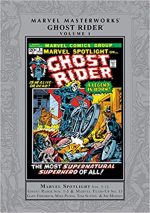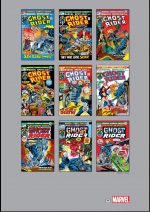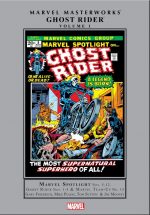


By Roy Thomas, Gary Friedrich, Marv Wolfman, Doug Moench, Len Wein, Mike Ploog, Tom Sutton, Jim Mooney, Herb Trimpe, Ross Andru & various (Marvel)
ISBN: 978-1302918170 (HB)
At the end of the 1960s American comicbooks were in turmoil, much like the youth of the nation they targeted. Superheroes had dominated for much of the decade; peaking globally before explosively falling to ennui and overkill. Older genres such as horror, westerns and science fiction returned, fed by radical trends in movie-making where another, new(ish) wrinkle had also emerged: disenchanted, rebellious, unchained Youth on Motorbikes seeking a different way forward.
Green Lantern/Green Arrow, Jack Kirby’s Jimmy Olsen, Captain America and many others all took the Easy Rider option to boost flagging sales (and if you’re interested the best of the crop was Mike Sekowsky’s tragically unfinished mini-masterpiece of cool Jason’s Quest in Showcase). Over at Marvel, a company still reeling from Kirby’s defection to DC/National in 1970, canny Roy Thomas green-lighted a new character who combined the freewheeling, adolescent-friendly biker-theme with the all-pervasive supernatural furore gripping the entertainment fields.
Back in 1967, Marvel published a western masked hero named Ghost Rider: a shameless, whole-hearted appropriation of the cowboy hero creation of Vince Sullivan, Ray Krank & Dick Ayers (for Magazine Enterprises from 1949 to 1955), who utilised magician’s tricks to fight bandits by pretending to be an avenging phantom of justice.
Scant years later, with the Comics Code prohibition against horror hastily rewritten – amazing how plunging sales can affect ethics – scary comics came back in a big way and a new crop of supernatural superheroes and monsters began to appear on the newsstands to supplement the ghosts, ghoulies and goblins already infiltrating the once science-only scenarios of the surviving mystery men titles.
In fact, the lifting of the Code ban resulted in such an avalanche of horror titles (new stories and reprints from the first boom of the 1950s), in response to the industry-wide down-turn in superhero sales, that it probably caused a few more venerable costumed crusaders to – albeit temporarily – bite the dust.
Almost overnight nasty monsters (and narcotics – but that’s another story) became acceptable fare within four-colour pages and whilst a parade of pre-code reprints made sound business sense, the creative aspect of the contemporary fascination in supernatural themes was catered to by adapting popular cultural icons before risking whole new concepts on an untested public.
As always in entertainment, the watch-world was fashion: what was hitting big outside comics was to be incorporated into the mix as soon as possible. When proto-monster Morbius, the Living Vampire debuted in Amazing Spider-Man #101 (October 1971) and the sky failed to fall in, Marvel moved ahead with a line of shocking superstars – beginning with a werewolf and a vampire – before chancing something new with a haunted biker who could tap into both Easy Rider‘s freewheeling motorcycling chic and the prevailing supernatural zeitgeist.
The all-new Ghost Rider debuted in Marvel Spotlight #5, August 1972 (preceded by western hero Red Wolf in #1 and the aforementioned Werewolf by Night in #2-4).
This sturdy hardback and equivalent yet barely tangible digital compendium collects those earliest flame-filled exploits: adventures from Marvel Spotlight #5-12, Ghost Rider #1-5 and a terror-tinged Marvel Team-Up (#15), spanning August 1972 to November 1973 and supplemented by an informative Introduction from then editorial head honcho Roy Thomas on how the series came to be. At the collection’s conclusion there’s also an effusive Afterword by Mike Ploog as he relates ‘My Ride with the Ghost Rider’…
The comics thrills, spills and chills begin with that landmark first appearance introducing stunt biker Johnny Blaze, his fatally flawed father-figure Crash Simpson and Johnny’s devoted girlfriend: sweet innocent Roxanne Simpson.
Plotted by Thomas, scripted by Gary Friedrich and stunningly illustrated by Ploog, ‘Ghost Rider’ sees carnival cyclist Blaze sell his soul to the devil in an attempt to save his foster-father Crash from cancer. As is the way of such things, Satan follows the letter but not spirit of the contract and Simpson dies anyway, but when the Dark Lord later comes for Johnny his beloved virginal girlfriend Roxanne intervenes. Her purity prevents the Devil from claiming his due and, temporarily thwarted, Satan spitefully afflicts Johnny with a body that burns with the fires of Hell every time the sun goes down…
Haunting the night and terrorising thugs and criminals at first, the traumatised biker soon leaves the Big City and heads for the solitary deserts where – in ‘Angels From Hell’ – the flaming-skulled fugitive joins a biker gang led by enigmatic Curly Samuels: a resurrected agent of Satan attempting to destroy the protective Roxanne and claim Blaze’s soul.
No prizes for guessing Curly’s true identity then, since the next chapter (inked by Frank Chiaramonte) is entitled ‘Die, Die, My Daughter!’
The origin epic concludes with a monumental battle against ‘…The Hordes of Hell!’ (offering a rather uncomfortable artistic collaboration by Ploog & Jim Mooney), resulting in a torturous Cold War détente between the still nightly-transforming Blaze and the Lord of Lies, as well as the introduction of a new eldritch enemy in Native American Witch Man Snake-Dance…
With Marvel Spotlight #9 the tragically undervalued Tom Sutton takes over the pencilling – with inks by Chic Stone – for ‘The Snakes Crawl at Night…’ as Medicine Man magic and demonic devil-worship combined to torment Blaze just as Roxanne goes west to look for him. To further confound the accursed cyclist, Satan decrees that although he must feel the pain, no injury will end Johnny’s life until his soul resides in Hell… which comes in very handy when Roxanne is sacrificed by Snake-Dance and the Ghost Rider has to battle his entire deviant cult to rescue her…
In #10, ‘The Coming of… Witch-Woman!’ (Friedrich, Sutton & Mooney) opens with Blaze a fugitive from the police and rushing the dying Roxanne to hospital. Meanwhile, on the Reservation tensions remain high as Snake-Dance’s daughter Linda Littletrees reveals her own connection to Satan, culminating in a devastating eldritch assault on Blaze in #11’s ‘Season of the Witch-Woman!’ (inked by the incomparable Syd Shores).
That cataclysmic conflict continued into Ghost Rider #1 (September 1973), which further extends the escalating war between Blaze and the Devil whilst introducing a new horror-hero who would take over the biker’s vacant slot in Spotlight.
Linda Littletrees isn’t so much a Satan-worshipping witch as ‘A Woman Possessed!’, but when her father joins fiancé Sam Silvercloud in calling Boston-based exorcist Daimon Hellstrom for help, they are utterly unprepared for the kind of assistance the demonologist offers.
With Roxanne slowly recovering and Blaze still on the run, Ghost Rider #2 depicts the bedevilled biker dragged down to Hell in ‘Shake Hands With Satan!’ (Mooney & Shores) before the saga concludes in Marvel Spotlight #12 with the official debut of ‘The Son of Satan!’ by Friedrich, Herb Trimpe & Frank Chiaramonte, which reveals Daimon Hellstrom’s long-suppressed inner self to be a brutal scion of the Infernal Realm eternally at war with his fearsome father.
The liberated Prince of Hell swiftly rushes to Blaze’s aid – although more to spite his sire than succour the victim – and, with his own series off to a spectacular start, continues to take the pressure off the flaming-skulled hero. From Ghost Rider #3’s ‘Wheels on Fire’ (Friedrich, Mooney & John Tartaglione) a fresh direction is explored with more mundane menaces and contemporary antagonists such as the thuggish gang of biker Big Daddy Dawson – who has kidnapped the still frail Roxanne…
Blaze also learns to create a spectral motorcycle out of the Hellfire that perpetually burns through his body: a most useful trick considering the way he gets through conventional transport…
Eager to establish some kind of normal life, the wanted fugitive Blaze accepts a pardon by the State Attorney General in GR #4’s ‘Death Stalks the Demolition Derby’ (inked by Vince Colletta) in return for infiltrating a Las Vegas showman’s shady operation, leading to another supernatural encounter, this time against a demonic gambler dubbed Roulette in ‘And Vegas Writhes in Flame!’ by the transitional creative team of Marv Wolfman, Doug Moench, Mooney & Sal Trapani.
Closing up the show here – and slightly out of chronological order – is a yarn where Ghost Rider and Spider-Man battled a demented biker bad-guy. Marvel Team-Up #15 (November 1973 and by Len Wein, Ross Andru & Don Perlin) introduces lame-duck villain The Orb who had been maimed and disfigured years previously in a confrontation with Crash Simpson and now seeks belated revenge against his heirs in ‘If an Eye Offend Thee!’ He’d have been smarter to wait until Blaze’s roadshow was far away from superhero-stuffed New York City and its overly protective friendly neighbourhood webslinger…
Adding extra cachet following Ploog’s afterword are the August 1972 Marvel Bullpen Bulletins page announcing the debut of the Biker Ghost Rider and stunning selection of original art pages, cover and design sketches by Ploog, Chiaramonte, John Romita, Mooney & Shores, Gil Kane & Frank Giacoia and Andru & Perlin plus an eerie back-cover from FOOM #7 featuring early Ploog visualisations of the Blazing Biker.
In the 1990s The Original Ghost Rider reprinted these classic tales and the 13 covers by Mark Teixeira, Jimmy Palmiotti, Javier Saltares, Andy Kubert, Joe Quesada, Jan Anton Harps, Kevin Maguire, Brad Vancata, Mark Pacella, Jeff Johnson, Dan Panosian, Ploog, Klaus Janson, Michael Bair, Darick Robertson, Chris Bachalo, Kris Renkewitz & Andrew Pepoy suitably bring the fearsome fun to close for now…
One final note: backwriting and retcons notwithstanding, the Christian boycotts and moral crusades of 1980s and 1990s compelled the criticism-averse and commercially astute corporate Marvel to “translate†the biblical Satan of the early episodes into generic – and presumably more palatable or “acceptable†– demonic creatures such as Mephisto, Satanish, Marduk Kurios and other equally naff, low-rent downgrades.
However, the original intent and adventures of Johnny Blaze – and spin-offs Daimon Hellstrom and Satana (respectively the Son and Daughter of Satan), tapped into the late 1960’s global fascination with Satanism, Devil-worship and all things Spookily Supernatural which had begun with such epochal releases as Rosemary’s Baby (Roman Polanski’s 1968 film more than Ira Levin’s novel), so please remember these aren’t your feeble bowdlerised “Hell-lite†horrors here. These tales are about the real-deal Infernal Realm and a good man struggling to save his soul from the baddest of all bargains – as much as the revised Comics Code would allow – so brace yourself, hold steady and accept no supernatural substitutes…
© 2019 MARVEL.
